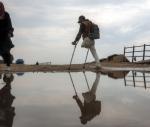You are here
It will only get worse
Mar 14,2023 - Last updated at Mar 14,2023
As Russia’s devastating war in Ukraine is entering its second year, with no end in sight, serious questions must be asked about the way forward.
At the end of year one, the toll tells the story. US government sources estimate that more than 130,000 Ukrainian soldiers have been killed or severely wounded. Estimates of Russian military casualties number between 150,000 and 200,000, with at least 60,000 of that total reflecting those killed, more than doubling the number of Russian soldiers killed in Afghanistan and Chechnya combined.
The impact on the Ukrainian people and economy has been even more consequential. The Ukrainian GDP declined by one-third. They have lost more than 40 per ceent of their electricity-generating capacity. And more than 8.5 million Ukrainians have been forced to flee their country to the West, with many more internally displaced as a result of widespread destruction of homes and infrastructure. As a result, Ukraine has become dependent on the West not only for weapons, but also for economic subsidies.
Because the war has not come home, Russians have been spared the death and devastation they have visited upon their neighbours. Sanctions imposed by the West have had an impact, but the Putin government has been able to draw on reserves to buttress their economy and found ways to circumvent sanctions to maintain a profitable, though diminished, level of exports and imports. As a result, the Russian economy shrank far less than expected in 2022 with the IMF even predicting some slight growth in 2023. And instead of mobilising the world against Russian aggression, the war has accentuated the preexisting divided between East and West, North and South.
Several developments should be noted. Most important is the fact that this has become an existential conflict for all parties. Ukrainian nationalism has proven to be a far more potent force than expected. Motivated by that and emboldened by Western military and political support, Ukrainian leaders now pledge to continue fighting until Russian forces are removed from every square inch of their territory.
Russia initially projected the view that Ukraine was an artificial country and sought to bring down its leadership through a devastating shock and awe assault. When this goal became unattainable, they settled on asserting their right to annex territories in the Eastern part of Ukraine that are heavily Russian speaking. Having been forced to surrender control in some of the areas they had initially occupied and now ground down in deadly combat on several fronts, Mr Putin is loath to surrender more territory or admit defeat fearing a threat to his leadership and vision of Russian destiny.
The US and its Western allies have also dug themselves into a rhetorical hole. Early on, President Biden sounded like a mix of Churchill and Reagan, mobilising the US and Western European opinion to join this battle to save democracy and freedom from authoritarian aggression and assuring everyone not only that it would be won, but also that it must be won.
Now one year after it began, the battle has not been won and all signs point to it continuing. The main combatants have shown remarkable resilience. The US and its allies are pouring new and more lethal weapons into Ukraine. Thus supplied, the Ukrainians are gearing up for a new offensive. And the Russians are holding their own, determined to commit new atrocities to weaken Ukrainian resolve.
The problem, of course, is that more weapons and more battlefield losses will not end this war, with all parties still believing they can and must be victorious. And so, we can expect more of the same in year two.
The writer is president of the Washington-based Arab American Institute













